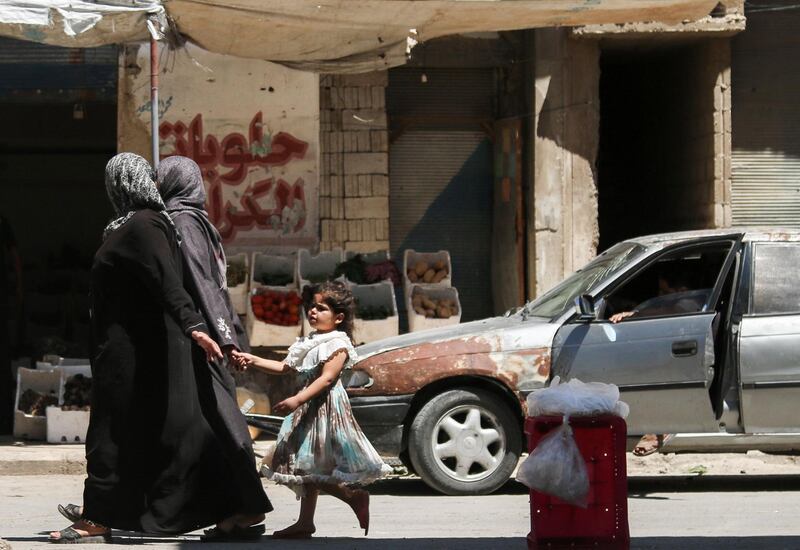Residents of a rebel-held enclave near the Syrian city of Homs waited tensely on Tuesday for the results of negotiations between rebels and Russian representatives after Moscow negotiators delivered an ultimatum.
Around 300,000 people have been under siege in and around the cities of Rastan, Talbiseh and Houleh in northern Homs province for more than five years. The area is the last significant piece of territory rebels control that is not adjacent to an international border.
On Monday, representatives of Russia’s military force in Syria offered rebel groups a deal to end the fighting in exchange for surrendering weapons and withdrawing to rebel-controlled territory further north, along the Turkish border.
“There will be either war or surrender. The international community has abandoned us,” said Suhayb Al Ali, a spokesman for the Homeland Liberation Movement, one of the largest rebel groups in the area.
Residents of the area were divided in what they thought about the negotiations, but their chief concern was being able to remain safely in their homes.
Deals between the rebel groups and representatives of the Russian military, which intervened in Syria’s civil war in 2015, have been referred by the UN as “forced displacement”. Many people have ended up in overcrowded, makeshift camps.
___________
Read more:
Syrian forces move to retake countryside north of Homs
Mostly Iranians killed in Syria strikes, monitor says
___________
Last month, tens of thousands of people were bussed from the formerly rebel-controlled suburbs of Damascus to rebel-held parts of northern Syria.
“The residents are relying on the negotiations. They refuse to be deported and encourage any agreement that will keep them in their areas because of the suffering in the camps,” said a Syrian journalist in Talbiseh. “People are sticking to their land and do not want to leave.
“But there is also a division that refuses to compromise with the [Syrian] regime.”
Abu Tareq, a resident of Tar Maleh — a village to the south of the enclave — said that the poor living conditions will force people out.
“Some said they will resist to the death, and others said they will leave because there are lots of children and civilians, and there is no food, bread, sugar or any necessities,” he said. “The regime, the Russians and the Iranians are using a scorched-earth strategy [to force people out].
“People are weak. They would not be able to resist more than two or three months.”
Still, Abu Tareq, was torn about what to do.
“If I have the choice, I will take the decision to wage war against the oppressor, but there are women and children. This is leaving us no choice,” he said.
Talbiseh and the nearby city of Rastan were seized by the rebels in the summer of 2012. Their strategic location along the country’s main north-south highway allowed rebels to cut off Aleppo, the country’s largest city, from Damascus and Homs.
Forces loyal to Syrian President Bashar Al Assad renewed their offensive against the area earlier this month in parallel to fighting around rebel-held territory in Damascus’s eastern suburbs, but ground forces were largely unable to breach rebel defences.
Earlier this week, as fighting around the eastern suburbs had ended, Damascus renewed its air and artillery assault against the enclave while redeploying ground troops from Damascus to Homs and threatening a renewed invasion.
The northern Homs area had been one of the four “de-escalation” zones agreed on by Iran, Russia, Turkey and Syria last year.
The journalist from Talbiseh said that the agreement, which did not entirely end hostilities but had reduced them, abruptly ended in February after Russian representatives rejected rebel demands and withdrew from negotiations.
“The Russian side avoided all items, such as opening the crossings and releasing the detainees, which were the most important conditions of the negotiating body in the northern Homs countryside,” the journalist said.
Mr Al Ali said he is deeply disappointed by the being forced out of the area.
“I have been crying since yesterday,” said the rebel spokesman. “My memory is working non-stop.
“I am recalling how in the beginning of the revolution we stopped a regime offensive with pump-action rifles. Now people are handing over heavy weapons as they leave their towns.”
The seizure of Rastan was also a symbolic victory for the rebels, after ranking Syrian army officers who hailed from the city defected to the rebel side early in the conflict.
“Rastan was the symbol of the revolution,” Mr Al Ali said. “For me, defending my land is better than expulsion. Even if I'm expelled to another area, the regime may follow me. Death is the natural end of life whatever you try to do to postpone it.
“If we leave, then Idlib will be the next target,” he concluded, referring to the northern province that would likely be the rebels’ destination in any deal.
*Additional reporting by Ahmed Barakat in Turkey





